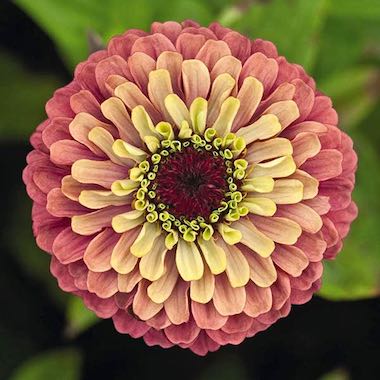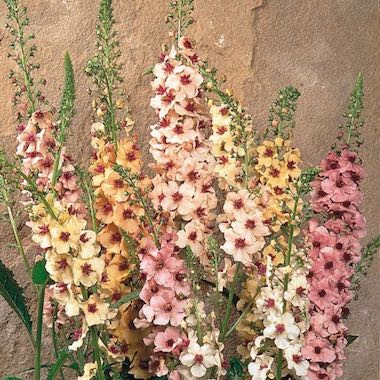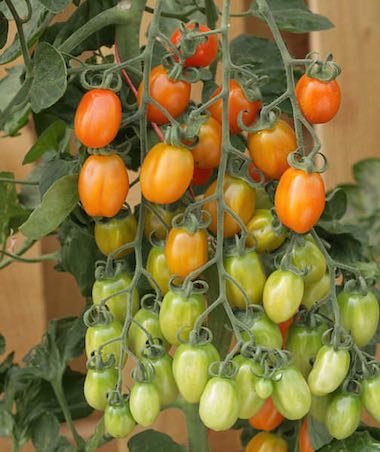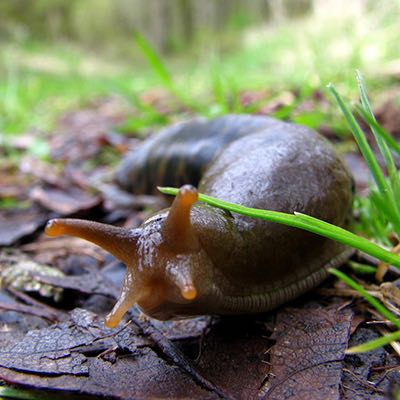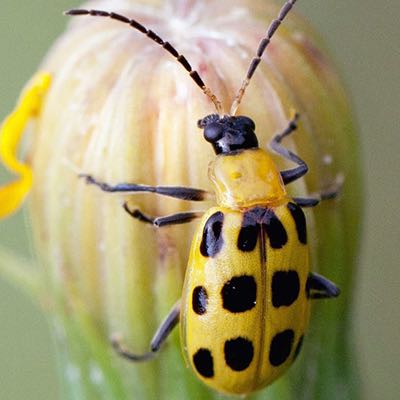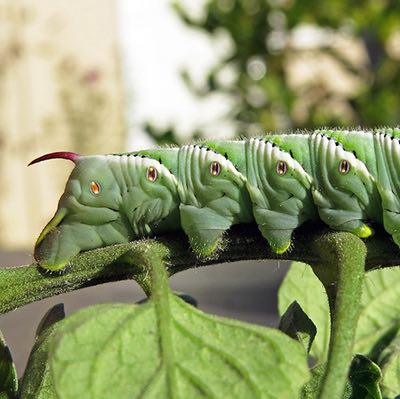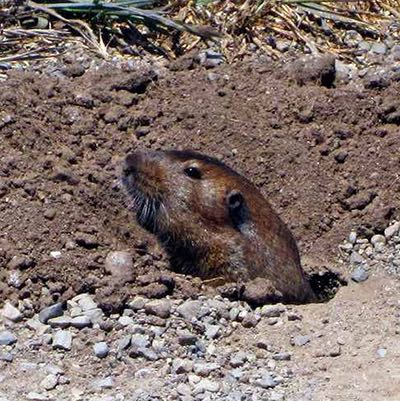Garden Pests
For all who are you tired of sharing the fruits, flowers and vegetables of your labor with pesky bugs and furry little critters, we would like to share what we know about common garden pests and how to control them.
Slugs and Snails


Ways to control slugs and snails in your garden:
● Water in the morning, not in the evening.
Watering in the morning allows the soil surface to dry out before nighttime when slugs and snails are most active. Slugs and snails prefer to travel on moist surfaces. Dry surfaces will slow down their activity and limit the subsequent damage to your plants.
● Share a beer with the slugs and snails.
Fill a shallow dish with beer and place it in your garden. Slugs and snails are attracted to beer and will drown when they go for a drink.
● Go hunting at night.
Slugs and snails are most active at night. Going out after dark with a flashlight will allow you to find the slugs and snails as they leave their hiding places in search of food. Some people like to salt the slugs. My grandmother likes to spear them with a chopstick. My mom likes to cut them with scissors and my nephew likes to collect and relocate. I prefer cutting them with scissors as I fear relocating or salting them could cause future problems in the garden.
● Build homes for slugs and snails.
Slugs and snails like to spend their days in cool, moist and dark locations. You can often find them hiding under pots, piles of leaves, dense shrubs and ground covers, boards, stones and just about anything else that may create a cool, moist and dark location. If you have spaces like this in or near your garden, check them during the day and you will likely find slugs and snails hiding in them. Regularly checking these ideal hiding places and killing them (or relocating them far away) will quickly reduce the slug and snail populations in your garden. If you don’t have any of these ideal slug and snail homes in your garden, building some will allow you to easily find these pests and begin controlling their populations. I keep only a limited number of ideal homes for slugs and snails in my garden so I can easily find them without having to search under every pot and leaf pile in my garden.
● Attract predators into your garden.
Snakes, frogs and some birds including chickens like to eat slugs and snails. Providing habitat for these predators will help keep the populations of slugs and snails under control. Be careful with chickens as they will also like to eat many of the plants in your flower and vegetables gardens.
● Create circles with sharp and gritty materials.
Surround your affected plants with diatomaceous earth, crushed eggshells, sand or other rough surfaces like lava rock. Slugs and snails will be deterred and/or killed by the barriers of sharp and gritty materials.
Decorate your pots with copper tape.
Copper can be used to build effective and long-lasting barriers to slugs and snails. It is believed that slugs and snails feel something like an electrical shock when they come into contact with copper. I’ve seen copper work well and not work at all. Maybe some slugs like the shock or whatever we’re growing on the other side of the barrier is worth the pain!
● Commercial Slug Baits.
Commercial baits are available in conventional and organic formulas. The safest options for people, pets and wildlife have ferric phosphate as the active ingredient. Other formulas use ferric sodium which is highly toxic. Do not put bait too close to your plants. Bait attracts slugs and snails but does not kill them right away.
Cucumber Beetles
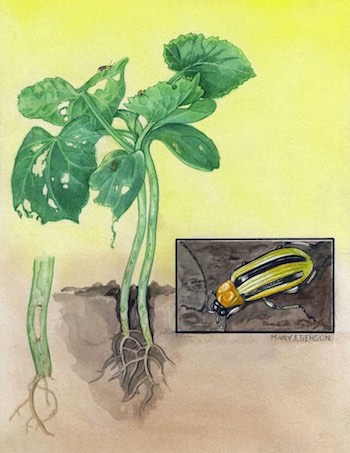
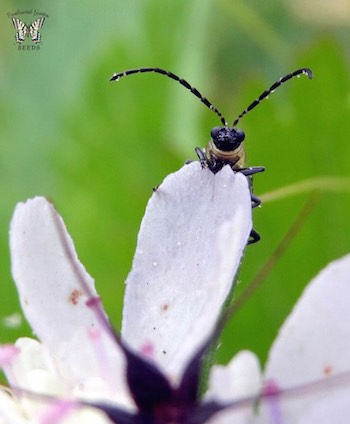
There are two types of cucumber beetles, striped (Acalymma vittatum) and spotted (Diabrotica undecimpunctata). Both types are about 1/4 inch long and yellowish-green in color (sometimes orangish-green), one with black lengthwise stripes and the other with black spots.
Both types of cucumber beetles are found throughout North America.
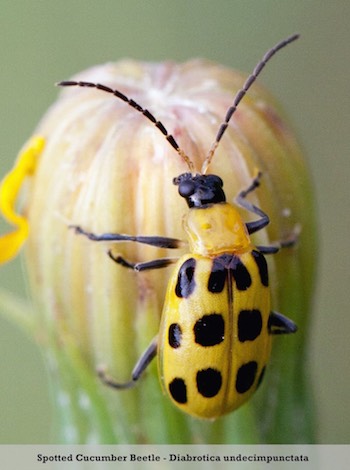
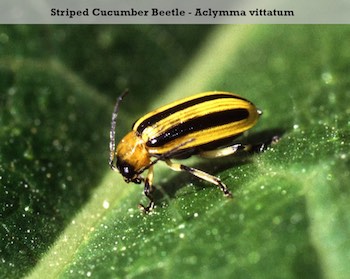
Both types of cucumber beetles love to feed on cucumber plants and other plants in the cucurbit family such as squash, pumpkins and melons. While striped cucumber beetles rarely feed on other types of plants, spotted cucumber beetles happily feed on hundreds of different types of plants including beans, corn, eggplant and many flowering ornamentals.
Striped cucumber beetles lay their eggs at the base of cucurbit plants such as cucumbers, squash and melons and their larvae feed on the roots of these plants. Spotted cucumber beetles tend to lay their eggs on corn and other grasses and their larvae feeds on the roots of these plants. Through the larvae feeding on roots and adults feeding on leaves, stems, flowers and fruits, cucumber beetles can stunt plant growth, decrease food and flower production, transmit diseases such as bacterial wilt and mosaic virus and ultimately kill plants, especially younger plants.
Cucumber beetle damage is visible in many forms and can look similar to damage caused by other pests. Yellowing, wilting or misshapen leaves, leaves with holes in them, stunted plants and stunted fruits are all common signs of cucumber beetle damage.
Ways to control cucumber beetles in your garden:
● Use your fingers.
In my small personal garden, I often try to kill cucumber beetles one-by-one with my fingers. This method can work quite well if done consistently throughout the growing season. If you’re looking for cucumber beetles in your garden, they can often be found on leaves or flowers and are sometimes hiding on the underside of leaves. When disturbed, they may fall to the ground and go into the soil or quickly fly away. If you want to kill them by hand, you’ll need to move fast.
● Use a vacuum.
On larger farms and when infestations are worse, vacuums can be used to capture large numbers of the pests. I’ve had friends successfully use shop vacuums and leaf blower/vacuums.
● Keep your garden clean.
Adult cucumber beetles can overwinter in dense grasses, leaves and other garden debris, both above and below ground. Cleaning up the garden after harvests and between seasons can help limit the number of cucumber beetles you’ll have in the future.
● Use row cover on seedlings.
Covering seedlings with row cover (or similar type of cover that allows air and light to pass through) until they’re mature enough to handle some minor to moderate pest damage can help prevent loss of plants even if cucumber beetles are present in your garden. Row cover should be removed once plants begin to flower so you can fully enjoy the flowers and allow for pollination if you’re growing fruits and veggies.
● Attract beneficial insects.
Beneficial insects such as ladybugs, green lacewings and soldier bugs can be purchased and added to your garden or attracted to your garden by planting marigolds, calendulas, daisies, dill and other plants that attract beneficial insects. Beneficial insects feed on the cucumber beetles and their larvae.
● Use traps.
There are multiple types of traps that can be purchased or made. Sticky traps with pheromone lures can catch quite a few. They typically need to be replaced every 3 to 4 weeks and even most small gardens will need multiple traps to ensure adequate coverage.
● Use natural insecticides.
Natural insecticides such as neem oil and insecticidal soap can be used to control cucumber beetle populations. These work best when applied liberally to all surfaces of the plant, including the underside of the leaves. After any significant rain, new applications of neem oil or insecticidal soap will be needed if plants are still too small to handle some damage from remaining cucumber beetles.
● Spray with clay.
I have not tried the following method but it sounds like it can work quite well. Spraying young plants with a protective barrier of kaolin clay, sold under the name Surround WP, can significantly decrease damage caused by cucumber beetles. When spraying plants, it is important to spray the underside of leaves as well. For best results, a new coat will need to be applied after each time it rains. Once plants are large enough to handle some damage from cucumber beetles, you can stop applying additional coats.
Tomato Hornworms
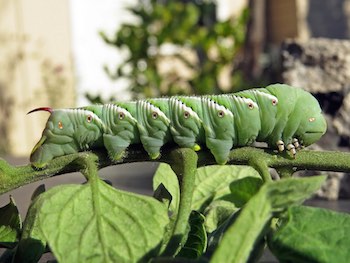
Tomato hornworms are very large caterpillars that can grow up to four inches long. Adult caterpillars are bright green with white stripes and dark eye-like spots on each section of their abdomens. Coloration on young caterpillars is typically lighter but with similar patterns.
They’re fairly easy to identify but not always easy to find as they blend in with the foliage of their favorite food, the tomato plants in our gardens. You’ll likely find evidence of tomato hornworms in the form of dark green or black droppings and branches stripped of their leaves. Tomato hornworms will feed on both leaves and fruit. If you’re hunting for tomato hornworms, they’ll likely be near the edge of damaged areas. While tomato hornworms prefer tomato plants, they can also be found on weeds in the same family, the solanaceae or nightshade family, and on other cultivated crops like eggplants, peppers and potatoes.
Ways to control tomato hornworms in your garden:
The easiest way to keep tomato hornworm populations under control is to check plants 2 or 3 times a week. I check for damaged areas rather than checking for the caterpillars. I find it much easier to spot the damage and droppings than the camouflaged caterpillars. Tomato hornworms grow fast, they become full grown in as little as three weeks, so it is important to check frequently. Tomato hornworms get so big that I feel less inclined to squish them between my fingers and more inclined to wear gloves when hunting for them. Once found, remove by hand and drop into a container of soapy water unless you want to squish them between your fingers.
If you find a tomato hornworm with a cluster of white egg-like projections sticking out from its body, don’t kill it. The projections are eggs for a parasitic wasp. The larvae that hatch from these eggs will feed on the the hornworm and grow into the next generation of wasps that will help control the population of tomato hornworms in your garden. To attract more of these wasps to your garden, provide water for them to drink and plant parsley, dill and yarrow in and near your vegetable garden. Adult wasps feed on the nectar of these plants.
Keeping your garden free of weeds from the solanaceae or nightshade family and tilling soil between growing seasons will also help limit the number of tomato hornworms in your garden.
Gophers
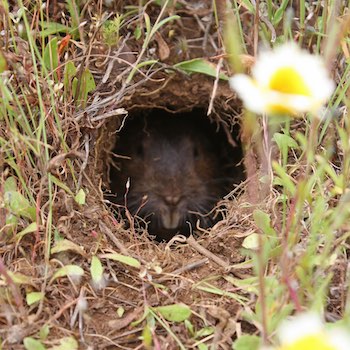
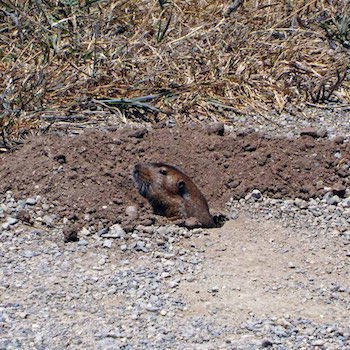
Are gophers a problem in your area? I grew up in an area without any gophers. I didn’t know how lucky I was to have my first garden in such a place. Moles were a problem in my first garden but they never killed any of my plants.
After I moved to Sonoma County, California, I quickly learned how much of a pest gophers can be. My first garden in Sonoma County was a small 12-foot by 12-foot plot that I surrounded with fencing in hopes of keeping out hungry deer and chickens. Even though the fencing wasn’t very tall, the deer stayed away (likely due to dogs and not my fencing) and the damage in my garden from the chickens was limited to the length of their necks poking through the fencing. This fencing did nothing to prevent damage from gophers.
I watched many of my kale plants shake from gophers chewing on the stems just before the plants were partially or entirely pulled underground. It was a bit humorous watching this happen the first time. After multiple losses in my small plot, I decided to take some action. I did some research on gopher traps and purchased two Victor The Black Box Gopher Traps.
In just over a week, I caught a dozen gophers in and around my small garden plot. After this extremely successful period, there was very little gopher activity in my garden for the rest of that season.
If you decide to try a Victor The Black Box Gopher Trap or any type of trap, please be careful and read all of the instructions before setting traps.
How to control gophers with Victor The Black Box Gopher Traps:
I look for mounds and holes, then I dig into the ground between them in search of a tunnel. Once I find a tunnel, I dig a hole big enough to handle two traps, one pointing each way in the tunnel. I like to use two traps per hole since I don’t know which way a gopher might be traveling through any given tunnel.
I dig holes in a way that allows the open end and bottom of the traps to sit flush against and on top of the soil. I try to set traps in a way that only allows light and air to enter the traps and tunnels through the one quarter-sized hole at closed end of the trap. I want gophers to push dirt toward this hole at the closed end of the trap and not at any point earlier in the trap. If too much light and air is allowed to enter earlier, like where a trap meets the tunnel entrance, a gopher may pile up dirt too soon and never trigger the trap. It seems like gophers are driven to close off new holes in their tunnels, so I do whatever I can to ensure there is only one new hole allowing light and air to enter a tunnel and that one hole is the quarter-sized hole on the other side of the trap's trigger.
I also like to dig a slight depression just before the trap's trigger. The depression is intended to hold some of the dirt being moved by a gopher. I feel like this decreases the chance that a gopher will fill the trap with soil before going far enough in to trigger it.
If you have small children or pets, you may want to cover the hole in some way to prevent any curious kids or pets from accessing the trap. I like to use 1/2 inch steel mesh weighed down with some heavy rocks.
Using the Victor ‘The Blackbox’ Gopher Trap in this way has given me consistently good results. Sometimes the traps have caught gophers less than an hour after being set.

If you have any herons visiting your yard, you may not need to do any trapping. Herons love to eat gophers!
Written by Ben.


